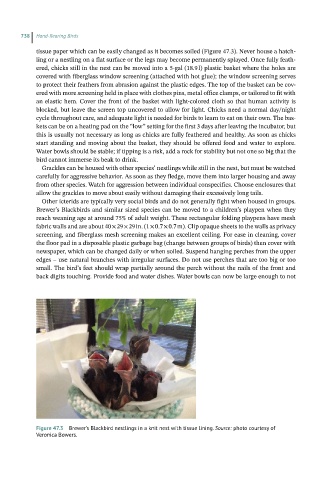Page 736 - Hand rearing birds second
P. 736
738 Hand-Rearing Birds
tissue paper which can be easily changed as it becomes soiled (Figure 47.3). Never house a hatch-
ling or a nestling on a flat surface or the legs may become permanently splayed. Once fully feath-
ered, chicks still in the nest can be moved into a 5‐gal (18.9 l) plastic basket where the holes are
covered with fiberglass window screening (attached with hot glue); the window screening serves
to protect their feathers from abrasion against the plastic edges. The top of the basket can be cov-
ered with more screening held in place with clothes pins, metal office clamps, or tailored to fit with
an elastic hem. Cover the front of the basket with light‐colored cloth so that human activity is
blocked, but leave the screen top uncovered to allow for light. Chicks need a normal day/night
cycle throughout care, and adequate light is needed for birds to learn to eat on their own. The bas-
kets can be on a heating pad on the “low” setting for the first 3 days after leaving the incubator, but
this is usually not necessary as long as chicks are fully feathered and healthy. As soon as chicks
start standing and moving about the basket, they should be offered food and water to explore.
Water bowls should be stable; if tipping is a risk, add a rock for stability but not one so big that the
bird cannot immerse its beak to drink.
Grackles can be housed with other species’ nestlings while still in the nest, but must be watched
carefully for aggressive behavior. As soon as they fledge, move them into larger housing and away
from other species. Watch for aggression between individual conspecifics. Choose enclosures that
allow the grackles to move about easily without damaging their excessively long tails.
Other icterids are typically very social birds and do not generally fight when housed in groups.
Brewer’s Blackbirds and similar sized species can be moved to a children’s playpen when they
reach weaning age at around 75% of adult weight. These rectangular folding playpens have mesh
fabric walls and are about 40 × 29 × 29 in. (1 × 0.7 × 0.7 m). Clip opaque sheets to the walls as privacy
screening, and fiberglass mesh screening makes an excellent ceiling. For ease in cleaning, cover
the floor pad in a disposable plastic garbage bag (change between groups of birds) then cover with
newspaper, which can be changed daily or when soiled. Suspend hanging perches from the upper
edges – use natural branches with irregular surfaces. Do not use perches that are too big or too
small. The bird’s feet should wrap partially around the perch without the nails of the front and
back digits touching. Provide food and water dishes. Water bowls can now be large enough to not
Figure 47.3 Brewer’s Blackbird nestlings in a knit nest with tissue lining. Source: photo courtesy of
Veronica Bowers.

